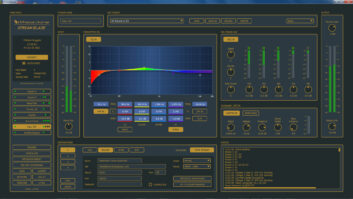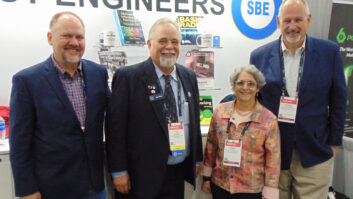Once upon a time — in a proto-Internet Age when the first-generation Pentium CPU was under development inside Intel’s labs — Leo Laporte was a weekday talk radio host at KNBR(AM) in San Francisco.

“Then this guy named Rush Limbaugh came along and put me and about 550 other midday broadcasters out of work,” Laporte deadpans. “So I ended up working weekends, doing a call-in show about technology.”
From those humble roots, Laporte has grown to become a “tech broadcast” guru.
His weekend radio show, “Leo Laporte: The Tech Guy,” is syndicated by Premiere Radio Networks to about 160 U.S. stations and Sirius XM. Meanwhile, Laporte’s weekly podcast “This Week in Technology” — aka TWiT — has become the flagship podcast/program of TWiT.tv. If you saw Laporte visiting the Ham Reception at this spring’s NAB Show, you know how well regarded he is among the techie crowd.
Operating out of the new “TWiT Brick House” studios in Petaluma, Calif., TWiT.tv now offers a range of technology-focused streaming video/audio shows. Thanks to Laporte’s innovative approach to advertising, TWiT.tv cleared $4 million last year and is on the road to making $6 million this year.
(click thumbnail)
Leo Laporte, center, is flanked virtually by ‘Ham Nation’ hosts Gordon West and Bob Heil in a Skype conference. Don Hill, bottom, is an expert on amateur television. (click thumbnail)
This view shows the techie feel and multi-set layout of the Brick House.


“We’re profitable, even though we have a staff of 16,” says Laporte. “That’s no small achievement for an Internet broadcaster.”
Rise of a TWiT
Leo Laporte’s ascension to tech guru fame was boosted by his television shows on TechTV, a turn-of-the millennium cable network dedicated to technology programs.

The TWiT Brick House opened this summer.
“Unfortunately, it cost about $50 million annually to keep TechTV going,” he says. “So when Paul Allen sold it in 2004, I focused on my weekend radio gig. Eventually I turned that into a syndicated show, but I still had five days a week to deal with. I needed something to fill my time.”
That “something” was to produce “This Week in Technology,” which started as a weekly podcast. The popularity of TWiT motivated him to offer other podcasts at www.TWiT.tv, which moved him inexorably towards live streaming video — shot and available live, or accessible afterwards on demand.
“Compared to broadcast or cable television, streaming video is extremely inexpensive,” Laporte says. “I can produce an hour’s worth of content for $1,000 all in, as compared to the $5,000–$7,000 an hour demanded by conventional TV production. One saving is that we go live; there’s no money spent in post-production editing.”
Add a menu of tech-centric shows such as Bob Heil’s “Ham Nation,” “Windows Weekly With Paul Thurrott” and “iPad Today” with Laporte and co-host Sarah Lane — and there’s lots of reasons for people to log on and watch for free.
“Leo has truly figured out how to make Internet broadcasting work,” says Heil, founder and CEO of Heil Sound.
Says Kirk Harnack, who co-hosts TWiT.tv’s “This Week in Radio Tech,” “Leo makes technology accessible without dumbing it down. He is the right person in the right place for this kind of innovative programming.” Harnack’s full-time job is executive director of sales and marketing for the Telos Alliance.

The facility uses Canon VIXIA HF G10 HD camcorders.
How he does it
TWiT.tv defies conventional wisdom about the Internet, because it makes money while offering free content. How does Laporte do it?
First, when it comes to advertisers, “I only have three sponsors per show — one per half hour — and the ad is restricted to a single, longer-form commercial read by the host,” he says.
“I knew that Internet users would not tolerate a stack of nine spots back-to-back, and I also knew that host endorsements have real power. So we have adopted this approach, which hearkens back to radio’s earliest days, and it works.
“Our sponsors, which include Ford, GE and tech companies like Citrix and Audible.com, are willing to pay $80 CPM for this kind of exposure.”
Second, TWiT.tv’s studio consists of four sets centered on a single “operator console” that includes all of the network’s production controls.
“We take video from 30 consumer camcorders mounted throughout the studio, plus a few pan-and-tilt cameras,” Laporte says. “The video is switched using a Tricaster, and the audio is handled by a Telos Axia Element, which that company provided as part of its work with us.” Laporte also has purchased a smaller Axia Radius for use in his own studio.

Looking out from TWiT.tv’s ‘operator console’ position.
All production is handled by a single operator, which keeps costs way down. Guests in distant locations are brought in via video Skype, their images shown on large LCDs located beside the on-air host.
“The switcher is part of the show, just like a board operator on a radio station,” he says. “They add to the show, which is why they have a camera and lights on them.”
TWiT.tv also keeps its bandwidth costs down to a bare minimum, by having bandwidth providers such as AOL, Cachefly, Ustream.tv, Justin.tv, YouTube and bit gravity distribute its shows. “They carry our shows using their own bandwidth, which makes this model work for us.”
By combining the best parts of TV, radio and the Web, and figuring out how to attract advertisers to buying time on streamed media, Leo Laporte appears to have cracked the challenge of making Internet broadcasting pay.
However, he’s not resting on any laurels. “We still have more time slots to fill out in our schedule, to make it truly 24/7,” Laporte says. “My goal is to be the CNN of tech broadcasting. We’re not there yet, but by building a studio that looks good to our viewers and adding more shows, we are well on our way.”
Equipment List for the TWiT Brick House
Internet Connections
Sonic.net Flexlink “Ethernet in the First Mile” (EFM, also known as IEEE 802.3ah). This connection is 35Mbps symmetrical. It is used for most of the Skype calls during the netcasts and to stream out the BitGravity, Ustream and Justin.tv video. The studio has two EFM connections, one for the streams and video calls, the other as the studio LAN. Also: ISDN Line from AT&T is used to stream studio audio to and from the Premiere Radio Networks studios for “The Tech Guy” show. A Comcast fiber optic cable connection is coming soon and will provide a 100 Mbit symmetrical connection in conjunction with the EFM.

Laporte with Heil mic
Audio Mixing
Telos Axia Element control console and Powerstation processing unit (main mixer); Telos Axia Radius console (Laporte’s mixer)
Microphones
Heil Sound PR40 dynamic table mics with BSW RE27POP filters; Countryman headset mics; Heil Sound PL2T Boom Mount
Headphones
AKG K240 DF; Ultimate Ears 4 Pro in-ear-monitors
TWiT.am Audio Stream
Barix Instreamer 100
Video Cameras
Canon VIXIA HF G10 Full HD Camcorder with Blackmagic Design HDMI to SDI Mini converters
Televisions
Vizio HDTVs
Blackmagic Design SmartView Duo SDI displays
Video Switcher
Tricaster 8500 Extreme with 850CS control surface
Router
Blackmagic Design Broadcast Videohub 72×144
Computers and Monitors
Many TWiT hosts use various models of MacBook Air or MacBook Pro, with exceptions like Brian Brushwood, often seen with a 17-inch Windows-based notebook PC.
Lights
140 lighting fixtures purchased, installed and configured by Brent Bye of Ocean Studio, Santa Monica.












